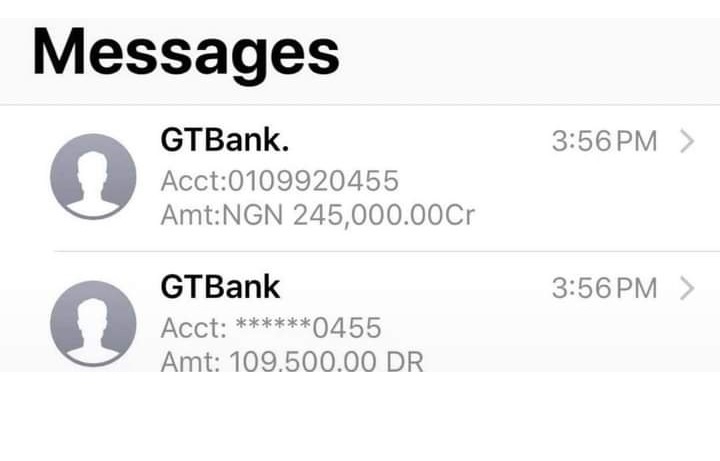Fake credit alert is one of the widely perpetrated scams in Nigeria. In this type of scam, you’d receive a credit alert for the payment of a service you render or goods you sell, but this payment would not reflect on your bank account. It can be disheartening to find out later on that you’ve been scammed by a fake credit alert. In this article, we’ll be providing you with tips to use to confirm the authenticity of a credit alert so you won’t be a victim of this menace that’s becoming quite rampant in Nigeria. Read on.

How to detect a fake credit alert in Nigeria would be discussed below:
-
Confirm Your Account Balance
One way to confirm if a credit alert you received for a transaction is authentic is to confirm your account balance by making use of your bank’s mobile banking app, internet banking channel, or USSD code. Alternatively, you can reach out to your account manager to request your available bank account balance. A fake credit alert would never reflect in the balance of your account. Remember you must have the precise figure of your last known available balance so you can be sure if there has been a successful credit transaction into your account or not.
-
Check Your Email
If you subscribed to receive email alerts with your bank, you’d surely receive alerts for every transaction. However, be sure to confirm the email address sending the credit alert to your email is associated with your bank. Sometimes, these fraudsters may go further by sending you an email with an address similar to that of your bank, to fool you. So, if you’re not sure what the email address associated with your bank is, you can check the website of your bank to confirm the bank’s email.
-
Check the Credit Alert for Your Available Balance
Another tip for determining if the credit alert you received is genuine is to check the available balance section of the alert. Normally, an authentic credit alert would contain the available balance of your bank account. Let’s use this example to drive home the point: If you had NGN625,000 as your bank account balance, and NGN75,000 was sent to your account, you should have N700,000 as your available balance on the credit alert for the transaction (you may notice some deductions, like NGN50 for transactions above NGN10,000, per CBN’s directive to banks)
So, from the example above, if the credit alert you receive does not contain NGN700,000 (taking into consideration the deductions as explained above), it means that the credit alert is fake.
-
Look Out For Discrepancies in the Credit Alert
Although fake credit alerts try to mimic authentic credit alerts, if you look closely at them you would notice some discrepancies. First, check the sender ID of the SMS you received to be sure it is the same as the legitimate credit alert from your bank. If the sender ID is different from that of your bank, it should tell you that it is fake. Check if the sender ID is in uppercase instead or lowercase and vice versa. For example, if you bank with Union Bank of Nigeria, the authentic credit alert sender ID would be ‘UNIONBANK’. Therefore, if you receive a credit alert with ‘Union bank’, ‘ubn’, etc, as the sender ID, that’s a telltale sign that the SMS is fraudulent.
Other discrepancies to look out for are stand-out spelling, punctuation, or grammar errors. If the credit alert contains cut-off sentences, misspellings, improper grammar, strange use of language, or awkwardly structured sentences, it’s a sign that it’s fake. Check the authentic credit alert messages you had previously received and compare them with the suspicious alert you receive to pick out the differences.
-
Use Your ATM
Another way to confirm if your account was truly credited is to take your debit card to the nearest automated teller machine (ATM) near you, slot in your card, and check your account balance. If your available balance remains your last known available balance, then it means the credit alert was a fake one.
-
Important Tips to Avoid Falling Victim to Fake Credit Alerts
Normally, you would be asked for your account number for you to get paid for the goods you sell or the services you render. If you’re asked to also provide your phone number and/or email address to get paid, then you should be wary of such individuals as your email or phone number is not required for a payment to be made into your account.
Furthermore, you should ensure you have the contact of your account handy so you can ask to confirm whenever you need to. It could also be helpful if you have the phone number of customer service personnel, operations officer, or manager of your bank. You can always check the website of your bank to get the contact details of those who could help you in situations such as the case of suspicion of a fake credit alert.
As we stated earlier in this article, you can use your bank USSD code to confirm your bank account balance. To use this service, you would be required to make a formal application for the USSD service in any branch of your bank near you. So, if you’ve yet to do so, kindly do so so you can be able to determine if a transaction reflects in your account or not, at any time.
Another important thing to do to easily verify the authenticity of a credit alert is to have the mobile app on your bank installed on your phone. But you’ll need to apply to be able to make use of mobile banking service. With the mobile app, you can confirm the credit alert regardless of the time of the transaction, particularly at night time or during the weekend when it might be impossible to get in touch with bank officials.